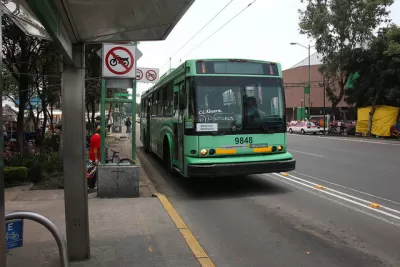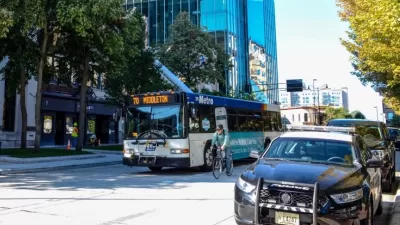The curious and, at times, dangerous design of bus lanes that move against the flow of traffic in Mexico city will be expensive and time-consuming to take out, so the city looks for ways to work with what it has.

Mexico City's buses sometimes drive in their own lanes in the opposite direction of traffic on one-way streets. The design was created in the '70s when the city was looking for ways to increase the throughput of private vehicles. The one-ways allow for wider lanes and higher speeds, and accommodate bus travelers who would have to walk to more distant one-way streets to catch a bus.
So the city built bus-only lanes for buses to go in the opposite direction of traffic. A problem with this design is that drivers sometimes do not recognize the uncommon design and pull into the lane of the oncoming bus. "World Resources Institute, a research organization that found a 146 percent increase in pedestrian crashes and a 35 percent increase in vehicle collisions in counterflow lanes," Natalie Schachar reports in CityLab. Unfortunately, updating these streets would cost $6 million per kilometer. "For now, the next best solution appears to be optimizing bus corridors by installing better signaling, mid-block crossings, and physical barriers to prevent vehicles and pedestrians from straying into the wrong lane," Natalie Schachar writes.
FULL STORY: Why Mexico City Has Counterflow Bus Lanes

Study: Maui’s Plan to Convert Vacation Rentals to Long-Term Housing Could Cause Nearly $1 Billion Economic Loss
The plan would reduce visitor accommodation by 25,% resulting in 1,900 jobs lost.

North Texas Transit Leaders Tout Benefits of TOD for Growing Region
At a summit focused on transit-oriented development, policymakers discussed how North Texas’ expanded light rail system can serve as a tool for economic growth.

Why Should We Subsidize Public Transportation?
Many public transit agencies face financial stress due to rising costs, declining fare revenue, and declining subsidies. Transit advocates must provide a strong business case for increasing public transit funding.

How to Make US Trains Faster
Changes to boarding platforms and a switch to electric trains could improve U.S. passenger rail service without the added cost of high-speed rail.

Columbia’s Revitalized ‘Loop’ Is a Hub for Local Entrepreneurs
A focus on small businesses is helping a commercial corridor in Columbia, Missouri thrive.

Invasive Insect Threatens Minnesota’s Ash Forests
The Emerald Ash Borer is a rapidly spreading invasive pest threatening Minnesota’s ash trees, and homeowners are encouraged to plant diverse replacement species, avoid moving ash firewood, and monitor for signs of infestation.
Urban Design for Planners 1: Software Tools
This six-course series explores essential urban design concepts using open source software and equips planners with the tools they need to participate fully in the urban design process.
Planning for Universal Design
Learn the tools for implementing Universal Design in planning regulations.
Ascent Environmental
Borough of Carlisle
Institute for Housing and Urban Development Studies (IHS)
City of Grandview
Harvard GSD Executive Education
Toledo-Lucas County Plan Commissions
Salt Lake City
NYU Wagner Graduate School of Public Service





























